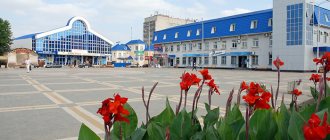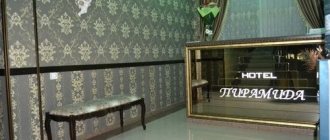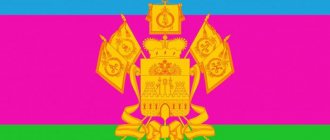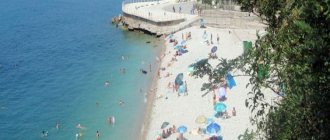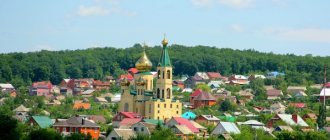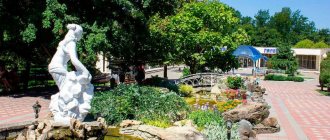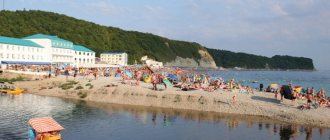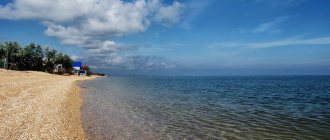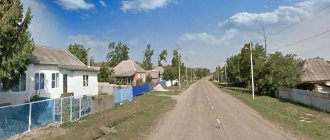The ancient land of the Krasnodar Territory - the Taman Peninsula - is a fertile, sunny place located on the Kuban Plain. The city of Taman stands on the shores of two seas - the Black and Azov, they are united by the Kerch Strait. This ancient Kuban village of the Temryuk region has a very long history and multinational cultural heritage, which is why tourists come here who are interested in not just a still sea holiday, but also filling in the gaps in their knowledge.
Name Features
The famous linguist and linguist Max Vasmer believed that the name “Taman” comes from the proper name of the Old Russian, which takes its roots from the concept of “a certain rank” (taman, a word in the ancient Turkic dialect). There is another version of the etymology of this word, according to which the designation “Taman” comes from the Adyghe word “swamp” (“temen”). It is possible that the name came from the Kabardian word, which means “lake”. Another translation is “sole” (“Taman” - in the Turkic dialect).
Turkish fountain
In the village of Taman there is a Turkish fountain, the only surviving monument from the period of Turkish rule. This is the only source of drinking water of its kind that is still functioning, built from pottery pipes.
This structure was first mentioned in his notes from 1666 by the Turkish traveler Celebi. They were written that in one of the Taman fortresses there was a spring that provided excellent drinking water in any weather. Later, engineers spent a long time trying to figure out where the water came from. Only after some time it became clear that the water in the Turkish Fountain is produced independently. It turns out that this is simply water condensation formed from the air and settling on the walls of the structure. Then the condensate flows down, giving people the much-desired and healing water, which contains silver ions.
Geographical location
This settlement is located in the western part of the Taman Peninsula (this peninsular part is often also called Taman). The location of the village is the shore of the Taman Bay, which is located on the territory of the Kerch Strait.
A few kilometers from the southern part of the village (in a village called Volna), it is planned to build a cargo port of international importance on the Black Sea coast. The port will be called Taman. Currently, preparatory work is being carried out on the construction of a bridge that will run to Crimea.
Cossack Museum
The Cossack Museum, the exhibition of which is dedicated to the culture and life of the Cossacks of the Taman Peninsula, appeared thanks to the efforts of the concerned residents of the village of Taman. A significant number of artifacts from past years related to the military and civil life of the Cossacks one and a half to two centuries ago have been collected here.
The museum itself was organized with the help of local residents: Cossack ataman V.I. Bystrov and his wife, who now serves as its director. They chose an old estate built in 1913 as the museum building. The exhibits include bladed weapons and firearms of the Cossacks of that period, Cossack uniforms from the 19th – early 20th centuries, horse harnesses, royal coins and photographs. All this is collected in relatively three rooms of the building. Some of the exhibit items were purchased by the Bystrovs at their own expense, and some were received as gifts from village residents.
Historical features
The early history of this village is known. Around 592 BC, the inhabitants of Ancient Greece built a city called Hermonassa. In 2008, namely on September 4, the city of Hermonassa (other names are Tmutarakan and Taman) celebrated its 2600th anniversary of its foundation. Bishop Tikhon of Yeisk (this clergyman extends his activities to the Kuban and Ekaterinodar diocese) consecrated a chapel for the Orthodox, which was erected in honor of Fyodor Ushakov.
Until the fourth century AD, this settlement was a Greek polis, which was called Hermonassa. In the seventh century the city began to belong to Byzantium. During this period the village was called Matarkha.
After the eighth century, the settlement began to belong to the Khazars. According to Arabic literary sources that were written during this time period, the city was called Samqush al-Yahud. This may indicate that a large community of Jewish people lived here during this period. According to another version, at this time such a religion as Judaism was widespread among representatives of the Khazar noble people.
In the eleventh century, Tmutarakan appeared, in which a predominantly Slavic population lived. After the Khazar Kaganate ceased to exist in 965, Prince Svyatoslav Igorevich again returned this settlement to his power. During this period, the village was famous for its trade connections and a large, well-equipped harbor. It was through Tmutarakan that interactions of a political and economic nature were carried out between individual Slavic principalities, and connections were also established with the Byzantine population and peoples living in the North Caucasus. The settlement was inhabited by Circassians, Greek people, Russians, as well as representatives of the Armenian diaspora.
In the eighteenth century, Johann Thunmann (a historian originally from Sweden) came to the region, who conducted research on the nationalities living in the village. It was he who noted the large number of Armenians and Greeks in this region.
In the tenth century, Tmutarakan was surrounded by an impressive brick wall, which was designed to perform a protective function. In 1023, Prince Mstislav Vladimirovich built a sacred temple here in honor of the Mother of God. A few years later, Prince Gleb measured the sea, which is located between Tmutarakan and the village of Korchevoy.
According to archaeological research carried out over many years, as well as on the basis of written historical sources, the site can be correlated with the following names of historical significance:
1. Matarkha Polovtsian (twelfth century and early thirteenth century); 2. Matrika Mongolian (mid-thirteenth century and early fourteenth century); 3. Matrega of Genoa (fourteenth and fifteenth centuries); 4. Hunkala Turkish, later Taman (seventeenth century and mid-eighteenth century).
In August, in 1792, in the place where the modern village of Taman is now located, the Black Sea Cossacks landed. Until 1849, from a formal point of view, this settlement could be considered a city. In fact, Taman was governed by the governing bodies of the village of Akhtanizovskaya. After 1849, Taman began to be considered a village.
For a long time, Taman was the residence of military judge A. Golovaty. It was in this region that the Cossack flotilla was located. During the Great Patriotic War, Taman acted as the epicenter of brutal bloody battles with many casualties. In 1943, the fighting in this area was the result of victory in the battle for the Caucasus region, and also led to the liberation of Kuban from the fascist invaders.
Tmutarakan
Years and centuries passed. During its existence, the city was part of various states and empires. Depending on this, its name also changed. One of the interesting moments for us is the period of the X - XI centuries AD. At this time, Svyatoslav Igorevich (Grand Duke of Kievan Rus) defeated the Khazar Kaganate, which included the lands of the Taman Peninsula. The city began to be called Tmutarakan. Then the Tmutarakan principality was formed, which was part of the ancient Russian state of Kievan Rus. For a general understanding of the “picture”, let’s move a little away from the topic and slightly refresh our memory of that historical period. Svyatoslav Igorevich was a great commander of his time. He fought with the Byzantine Empire, captured the Bulgarian kingdom, crushed the Khazars and Pechenegs, and annexed all the southern lands (from Bulgaria to the Kuban and Volga rivers) to Kievan Rus. He was the grandson of Rurik (the founder of the first ruling dynasty of Rus'. The last in the dynasty was the son of Ivan the Terrible - Tsar Fedor Ivanovich). Let's turn the wheel of history back a little, during the reign of Rurik.
We will not consider the origins of Rurik himself now. There are several theories on this matter and it is not yet possible to choose the only correct one. Let us dwell on the fact that Rurik was invited to Rus' and he began to reign. The capital of the principality was Novgorod. In order to somehow strengthen power, Rurik distributed new territories and settlements to “his husbands” (i.e., the best and most experienced representatives of his squad). Two Varangians, Askold and Dir, wanted to go on a campaign against Byzantium together “with their family.” In essence, by leaving, they refused to support Rurik. In the southern lands they had to stop at the “small town” of Kyiv, which at that time was paying tribute to the Khazars. History does not know whether they captured it or were invited to defend the city, but soon Askold and Dir began to rule Kiev.
In 879 Rurik dies. Before his death, he transfers power to his relative, Prince Oleg. He also asks to take care of his little son Igor. Oleg was a very worthy person and did a lot for Rus'. He was nicknamed “Prophetic” (knowing and predicting the future), as he was in no hurry to make decisions and always weighed all the arguments. This approach subsequently led to the desired result. The great Russian poet Pushkin A.S. dedicated a poem to him with the following beginning: “How the prophetic Oleg is now planning to take revenge on the foolish Khazars...”. Oleg united the northern lands of Rus' under his leadership and protected them from the raids of nomads. He gathered a squad and went to the southern part of Rus'. Approaching Kyiv, he announced to Askold and Dir: “You are not princes or of a princely family, but I am of a princely family.” In addition to everything, he presented them with Prince Igor, the son of Rurik. After this, Askold and Dir were executed, since they had previously not wanted to be subordinate to Rurik, but wanted to become his equals. Prince Oleg united the northern and southern lands of Rus' into one ancient Russian state called Kievan Rus (became the founder of Kievan Rus). He made Kyiv the capital and moved to it from Novgorod.
In 907, Oleg equipped several hundred rooks (a large boat). Having loaded his squad onto them, he set off to conquer the capital of the Byzantine Empire, Constantinople (Constantinople, and later Istanbul). As he approached, the Byzantines closed the city gates and blocked the port with chains. Oleg understood that the city could not be taken by storm. Then he ordered to put all the boats on wheels, tighten the sails and go to the city. Seeing such a psychological attack, the Byzantines were dumbfounded and decided to conclude a peace treaty with Oleg. According to it, Byzantium paid a huge tribute and allowed the Russians duty-free trade. In honor of this victory, Oleg nailed his shield to the gates of Constantinople.
In 912, Prince Oleg dies and power passes to Rurik's son Igor. As always, at such transitional moments, some of the subject territories wanted to gain independence. Prince Igor managed to restore order. Subsequently, he concluded a peace treaty with the Pechenegs and carried out two campaigns against Byzantium (941, 944). Igor was married to Olga. Unfortunately, information about its origin has not been preserved. He had a son Svyatoslav. In 945, Prince Igor died while collecting tribute from the Drevlyans. Princess Olga became a regent (temporary ruler) for her young son. She was the first ruler of the Russian state to convert to Christianity. This happened several decades before the baptism of Rus' by its grandson Vladimir. Growing up, Olga's son Svyatoslav became more and more interested in military affairs. By the time he matured, he made an excellent warrior. With his squad, Svyatoslav went on long (at that time) hikes. In them he was very unpretentious, did not have tents or carts. His warriors tried to be like their prince. Therefore, the squad had very high mobility. Svyatoslav annexed many territories and Kievan Rus became a powerful state. For his courage in battles he was nicknamed “Brave”. In 972, Svyatoslav died in a battle with the Pechenegs.
Monument to Grand Duke Svyatoslav the Brave near the village. Withers
In 2005, a monument to Grand Duke Svyatoslav the Brave was erected on a hill near the village of Kholki, Chernyansky district, Belgorod region. The installation of the monument was timed to coincide with the 1040th anniversary of the defeat of the Khazar Kaganate by Svyatoslav. In those distant times, the lands of the Taman Peninsula were annexed to the ancient Russian state of Kievan Rus. That is, these lands became Russian for the first time. The Tmutarakan principality was formed with its center in Tmutarakan (Taman). It included the Taman Peninsula, the Azov region and the eastern part of Crimea with the cities of Korchev (Kerch) and Sudak. The Tmutarakan principality existed for a couple of hundred years.
State of the economy
In 2012, information appeared that a dry cargo port would be built on the territory of Taman, which would become the largest port in the entire territory of Russia. This will be the seventh largest port in the Krasnodar Territory. It was planned that the first ton of cargo products would be shipped in 2016, in September. In 2014, after Crimea became part of Russia, a different configuration emerged for Black Sea ports (there are five deep-water ports on the Crimean peninsula, we are talking about Feodosia, Kerch, Yalta, Yevpatoria and Sevastopol). In this regard, the project to create a dry cargo port on the territory of Taman is currently being revised.
Museum of Viticulture and Winemaking
Address: Taman village, st. Karl Marx, 98.
In this cultural institution, also included in the attractions of Taman, you can learn about the ancient craft of local residents, which is the cultivation of grapes and the production of wine from them. Considering the climate of the region, the appearance of such a museum is absolutely logical.
Viticulture itself on the Taman land originated in the era of antiquity, in the 6th century BC. It is not surprising that over the past time, vast experience has accumulated here in cultivating the sunberry and producing an intoxicating drink from it. In addition, a huge number of artifacts related to this trade have been preserved. These include various ceramic containers in which grape juice was pressed and wine stood. Visitors to the Museum of Viticulture and Winemaking, after viewing the numerous exhibits of the exhibition, can go to the tasting room, where they will be allowed to try the products of local winemakers, learn how to identify a bouquet and tell them which types of wine are combined with certain products.
About the sights
Taman is a settlement that is very interesting from a tourist point of view. Among the main places that tourists will surely like are the following:
1. An ancient settlement called Hermonassa-Tmutarakan. This attraction is an archaeological nature reserve, which is a federal property of all of Russia. The settlement has state protection. On the territory of this reserve there are numerous ancient monuments from various centuries. 2. Church of the Intercession. This shrine was erected in 1753. This is the first Orthodox church that was built on the territory of Kuban. The church was erected by Zaporozhye Cossacks. 3. Turkish wells. Such wells are an original hydraulic structure that was erected in the fifteenth century. The wells are still working. At the moment, this is the only source of condensation in the country. 4. The ramparts of the Phanagoria fortress, which were erected in 1794. 5. House-museum dedicated to M. Yu. Lermontov. 6. Taman Museum of Archeology. 7. A museum dedicated to the peculiarities of winemaking. 8. Tuzla's Scythe. 9. Ethnic park called Ataman. 10. Museum dedicated to the history of the Cossacks.
Address: Taman village, st. Karl Marx, 1.
The village of Taman is famous not only for its Cossack traditions. There is a real winery here, where regular excursions are held.
It is a branch of the larger enterprise OJSC Agro, engaged in viticulture and winemaking. In the vicinity of Taman there are the vineyards of this company, and on the territory of the village is its central estate with the main winemaking enterprise, which is equipped with modern equipment controlled by automation. Excursions are organized here to introduce tourists to the work of the plant and its products, which, as a rule, end with a visit to the tasting room and a small store with branded wines.
Celebrities associated with Taman
1. M. Yu. Lermontov (literary festivals are regularly held in Taman). 2. General N. Raevsky, who became a hero of the war with Napoleon. 3. The scientist D.I. Mendeleev was engaged in research of oil fields in this region. 4. The Decembrists, who were transferred from the Siberian regions to the Caucasus, also visited here. 5. Yuri Limansky (born 1926). Limansky is the creator of a private Cossack museum, which is the only one in the entire territory of Kuban. 6. A. A. Koldakov (1937 - 1993) - a native of Taman, a famous Soviet football player.
Housing in Taman in the private sector and hotels
You will not need to look for housing for a long time when you come on vacation to the resort town of Taman, because every second private house offers rooms, rooms, separate buildings for rent, with or without amenities. There are many guest houses and small hotels in the village, where you can comfortably spend your summer vacation on the Russian sea. A big plus in favor of a holiday in Taman is the more than budget price for housing, which starts from four hundred rubles per day, and increased competition forces local residents to create good conditions for tourists to have a pleasant stay. Many owners offer to rent accommodation with meals already included in the price. But, if you are not one of those who like to overpay for such a service, then you can cook yourself by purchasing all the necessary products at the local Taman market or supermarket.

